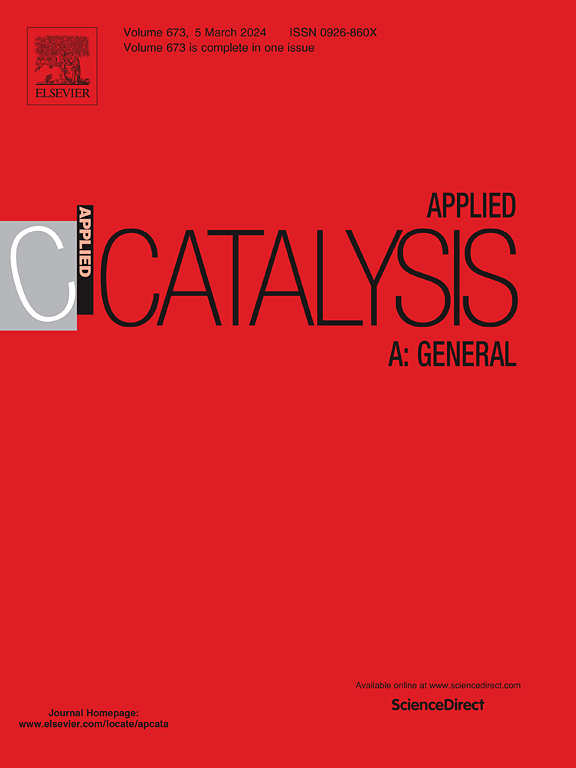Promotional effect of CeO2 and Fe2O3 species on mesoporous silica as efficient catalysts for the vapor-phase dehydration of iso-butyl alcohol to isobutylene
IF 4.7
2区 化学
Q2 CHEMISTRY, PHYSICAL
引用次数: 0
Abstract
CeO₂–Fe₂O₃ binary oxides were effectively incorporated into mesoporous spherical silica (MCM-41) via a sol–gel technique. The resultant CFO/MCM-41 nanocomposites, with metal loadings ranging from 3 to 30 wt%, were subsequently calcined at 550 °C and assessed as catalysts for the gas-phase dehydration of isobutyl alcohol. Structural and surface analyses using XRD, TG-DTA, ATR-FTIR, BET, TEM, EDX, XPS, and pyridine-adsorbed FTIR confirmed the formation of thermally stable, well-dispersed active phases, as well as the presence of both Lewis and Brønsted acid sites. The differences in catalytic activity among these nanocomposites were closely linked to variations in their acidity. Among all the catalysts, the 10 wt% CeFeO₃/MCM-41 sample demonstrated the best performance at 350 °C, achieving approximately 92 % isobutanol conversion, 100 % selectivity toward isobutylene, and a butene production rate of 45.10 mmol g⁻¹ h⁻¹ . The catalyst also showed excellent stability across five reuse cycles. The outstanding catalytic performance and stability were directly correlated with the material's enhanced structural integrity and optimized textural properties. Furthermore, XPS analysis revealed that the Ce3 +/Ce4+ and Fe2+/Fe3+ redox states, modulated by Ce–Fe interactions, played a crucial role in tuning the catalyst’s acidity and catalytic performance.
CeO2和Fe2O3对介孔二氧化硅气相脱水异丁醇制异丁烯的促进作用
采用溶胶-凝胶技术将ceo2 -Fe₂O₃二元氧化物有效地结合到介孔球形二氧化硅(MCM-41)中。所得到的CFO/MCM-41纳米复合材料的金属负载范围为3 ~ 30 wt%,随后在550℃下煅烧,并评估其作为异丁醇气相脱水催化剂的效果。利用XRD、TG-DTA、ATR-FTIR、BET、TEM、EDX、XPS和吡啶吸附FTIR对结构和表面进行分析,证实形成了热稳定、分散良好的活性相,以及Lewis和Brønsted酸位的存在。这些纳米复合材料的催化活性差异与它们的酸度变化密切相关。在所有催化剂中,10 wt% CeFeO₃/MCM-41样品在350°C时表现出最好的性能,其异丁醇转化率约为92 %,异丁烯选择性为100 %,丁烯产率为45.10 mmol g⁻¹ h⁻¹ 。该催化剂在5次重复使用循环中也表现出优异的稳定性。优异的催化性能和稳定性与材料增强的结构完整性和优化的织构性能直接相关。此外,XPS分析表明,Ce3 +/Ce4+和Fe2+/Fe3+氧化还原态在Ce-Fe相互作用下对催化剂的酸度和催化性能起着至关重要的调节作用。
本文章由计算机程序翻译,如有差异,请以英文原文为准。
求助全文
约1分钟内获得全文
求助全文
来源期刊

Applied Catalysis A: General
化学-环境科学
CiteScore
9.00
自引率
5.50%
发文量
415
审稿时长
24 days
期刊介绍:
Applied Catalysis A: General publishes original papers on all aspects of catalysis of basic and practical interest to chemical scientists in both industrial and academic fields, with an emphasis onnew understanding of catalysts and catalytic reactions, new catalytic materials, new techniques, and new processes, especially those that have potential practical implications.
Papers that report results of a thorough study or optimization of systems or processes that are well understood, widely studied, or minor variations of known ones are discouraged. Authors should include statements in a separate section "Justification for Publication" of how the manuscript fits the scope of the journal in the cover letter to the editors. Submissions without such justification will be rejected without review.
 求助内容:
求助内容: 应助结果提醒方式:
应助结果提醒方式:


